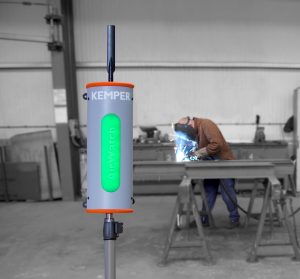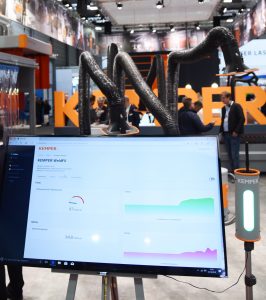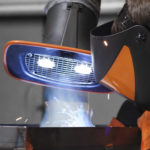Occupational Health & Safety 4.0 Today: What is the state of the art and how do welding companies benefit from it?
“On the pulse of digitalization” – this was the motto of this year’s EuroBLECH exhibition in Hannover. Networking is certainly on the rise in metal-working companies and brings numerous advantages: OH&S 4.0 – that is several smart appliances communicating with each other – is already a reality today. Modern technologies not only protect employees from hazardous substances more effectively but also help companies combat the shortage in skilled workers. An essay by Björn Kemper
Are you slowing occupational health and safety measures down? Do you not have a sufficient IT network? Or are you worried about importing external systems into your network? Although OH&S 4.0 – that is the consistent digitalization of occupational health & safety measures – is picking up speed, many companies still have reservations about it, even though they could benefit substantially from the networking involved.
Let’s take a look at the ideal welding company of the future. Machine-to-machine communication is fully developed. We have air monitoring systems measuring air quality, both stationary and mobile extraction equipment matching their output to what the work situation (material, welding procedures etc.) requires, room ventilation systems operate independently and react immediately to changes in air quality. Everything networked and automatically controlled by a cloud solution which continually collects data and optimizes processes, leading to a gradual increase in both energy efficiency and occupational health & safety effectiveness.
OH&S 4.0 is no longer a dream for the future
Much of it, in fact, is implementable today even without one’s own IT network. By integrating SIM technology into new or existing industrial safety equipment, machines can communicate with each other and operate independently. This technology is the starting point for networking and makes OH&S 4.0 attractive, even for small and medium-sized enterprises, especially since many production environments do not have an adequate digital infrastructure. No investment in an IT network is required for this technology.
Air monitoring systems: Monitoring and system control
Monitoring the hall air quality is indispensable for OH&S 4.0. Intelligent air monitoring systems permanently measure and control the air quality in working environments. As the risk is chiefly from respirable A-dust particles, state-of-the-art air monitoring systems rely on highly sensitive laser processes that detect particles of less than 0.3 micrometers in size. Manufacturers are working on other sensor modules which monitor both fine dust particles and other hazardous substances, such as nitrogen oxide and carbon monoxide.
 Precise air surveillance gives companies the security they need to comply with legally binding limit values. Companies can also better counteract possible stricter regulations in the future with OH&S 4.0 technology. In addition, detailed data enables production managers to identify trends or the effects of changes in production and then check the effectiveness of filter and extraction systems. A visualization, such as a traffic light switch on the device, also provides immediately visible information about the air quality.
Precise air surveillance gives companies the security they need to comply with legally binding limit values. Companies can also better counteract possible stricter regulations in the future with OH&S 4.0 technology. In addition, detailed data enables production managers to identify trends or the effects of changes in production and then check the effectiveness of filter and extraction systems. A visualization, such as a traffic light switch on the device, also provides immediately visible information about the air quality.
OH&S 4.0 is also synonymous with automatic control based on the collected data. In this respect, intelligent air monitoring systems not only display the recorded values but also save them in a cloud. This is where the SIM technology comes into play again. It transmits the instructions from the cloud to the networked extractors or room ventilation systems.
OH&S 4.0 for pistol extraction
How do the extraction units, and the employees operating them, benefit from the Cloud and its data? A lot. Smart pistol extractors are an example of how digitalized approaches unite occupational health & safety and energy efficiency. The extraction unit’s software has the parameters of numerous different burners that can be selected automatically by the user. The extraction unit takes different burner characteristics into account, such as individual pressure loss or filter saturation. By continuously updating the software with new data directly to the device via the cloud, the current parameters of even the latest suction burners are always available.
Independent room ventilation and predictive maintenance
Aside from spot extraction, the smart room ventilation system is another example of efficient OH&S 4.0 at work. The independent systems are fitted out with an air monitoring software package. Without any extra equipment, they measure particle concentration in the factory air and match their output to the figures obtained. The smart room ventilation system can be flexibly deployed either as an stand-alone solution or integrated into the OH&S 4.0 network.
 In the maintenance area, central extraction systems in particular benefit from the Internet of Things. Using appropriate sensor technology and a cloud-based, internet-enabled control module, vital information, such as differential pressure, temperature and residual dust monitoring can be easily called up on the internet. This makes automated, control-based processes possible and since all those responsible can keep an eye on the data from the cloud it also helps with predictive maintenance for equipment.
In the maintenance area, central extraction systems in particular benefit from the Internet of Things. Using appropriate sensor technology and a cloud-based, internet-enabled control module, vital information, such as differential pressure, temperature and residual dust monitoring can be easily called up on the internet. This makes automated, control-based processes possible and since all those responsible can keep an eye on the data from the cloud it also helps with predictive maintenance for equipment.
More safety, greater efficiency and attractive work places
OH&S 4.0 focuses on the optimal protection of employees from hazardous substances. Further benefits, however, arise from it. For instance, process automation as envisaged under OH&S 4.0 raises efficiency in manufacturing. Employees are free to concentrate fully on their principal tasks. A networked working environment also helps with the monitoring of extraction technology output and therefore, in effect, with reductions in energy consumption.
The deployment of air monitoring systems and other networked equipment creates an awareness for the value of cleaner inside air. This helps in both keeping and acquiring labor. A healthy work climate has a positive effect on employee satisfaction, which is extremely important in view of the continuing shortage of skilled workers.





